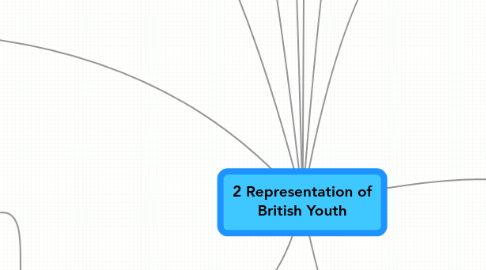
1. Current Tv, The Inbetweeners
1.1. Almost realistic portrayal, relatable to actual people
1.1.1. None of the characters are evil, yet social outcasts
1.1.1.1. Characters with right personality mix to create loveable characters
1.1.2. Characters shown trying to do the 'cool' things, like drinking but always goes wrong, no glamour or over the the topness
1.1.3. Focuses on their complicated relationships with adults, to highlight the difference in them.
1.2. likeable modern day version of please sir
1.2.1. Very successful both adults and youth like it
1.3. Aired on E4
1.3.1. deals with issues which are real but funny
1.3.2. Tv channel pretty much dedicated for 'youth'. think skins, misifts etc...
2. Current film, Harry Brown
2.1. Extremely negative, creates monsters, no separate identity per young character, don't get to know young characters that well, creates a collective identity.
2.1.1. Broken homes, blame is placed on youths but more on parents and other figures such as police. Main youth had bad upbringing mum doesn't care, dad is in prison, another is being sexually abused by his uncle.
2.1.1.1. Not a single good youth in the entire film.
2.1.1.2. No sympathy for youths though, personality less, they are they to be the enemy, scare the audience, well the older members of the audience.
2.1.2. dingy locations, underpasses accents, extreme language clothing one big stereotype with no depthdruggies, hoodies, alcohol, gun crime
2.2. Received positive reviews, 'best british film of the year'
2.3. Uses old man character, to become vigilante, whose best friend was murdered, instantly audience side with him other youths, not given any chance to get to know them at all, just instant evil characters.
3. Positive portayals, usually aspirational, Billy Elliot, Bend it like Beckham.
3.1. Tend to be sporty based films, not academic or being 'good' so to say.
4. Misfists
4.1. Outcast group of loveable characters, not meant to be negative nor positive, has a type of every teen character in the show.
4.1.1. Slut, chav, sportsman, funny one, slightly mental one etc...
4.1.1.1. Common group of teen characters, think first season skins.
5. Representation theories
5.1. Hall
5.1.1. Decoding and encoding, we take what we want from the media, and decide out own opinions on it, whether its what the creator intended or not.
5.1.2. "not a second mirror...new kinds of subjects"
5.1.3. Not a realistic representation of real life, need to read more about hall still!
5.2. Mulvey
5.2.1. Feminist, women only placed in media for male gaze.
5.2.2. "determining male gaze projects its fantasy onto female figure
5.2.2.1. 1975
5.2.3. Representations of the different sexes, reflect real life or not?
6. Older TV text Please Sir! 1968-1972.
6.1. Comedy around a young teacher and his troublesome class.
6.1.1. Language used was strong for it's time, seen as really mild for today though.
6.1.1.1. Aired on ITV
6.1.2. Almost more realistic from young person today, wouldn't stay negative portrayal.
6.1.2.1. Rowdy bunch, not nasty, but like to wind up older people
6.1.2.2. Don't dislike any of the characters, always a sense of fun. No violence or crimes.
6.1.3. Stereotypical characters: general outcasts next to posh, smart schools/students. -the slow 'less intelligent' one -the leader -the flirty girl -the funny one etc...
6.1.4. Clothing considered risky for era, short skirts makeup hair, smoking drinking
6.1.4.1. Contrast with older characters like the headteacher
6.1.4.2. Emphasises generation difference
7. Older film text
7.1. Billy Liar 1963. shows young man growing up, Billy and Liz show two different sides to youth.
7.1.1. Negative for the era, but almost laughable by todays standards, shows difference in considered 'bad' youth, from then to now.
7.1.2. Experimenting with personality and identity, shows him becoming an adult similar issues with today, partying, sex, and petty crimes, but nowhere near as extreme.
7.1.3. Blame isn't based upon parents, or adults like many todays programmes, comes from decent family, just his fault in a sense. Influenced by other character Liz who is free and does what she wants, wants to break free like her, but too scared.
7.1.4. Would almost sway more toward more positive portrayal compared to today's films, no demonisation of youth involved.
8. Article links
8.1. http://www.guardian.co.uk/film/2009/nov/05/british-hoodie-films
8.2. http://survivethejive.blogspot.com/2007/11/media-representation-of-british-youth.html
8.3. http://www.ukypforums.org.uk/showthread.php?t=2847
8.4. http://www.ljmu.ac.uk/MCA/91691.htm
9. General media theories
9.1. Adorno
9.1.1. "it proclaims you shall conform, with no instruction...replaced consciousness"
9.1.1.1. 1991
9.1.2. Almost saying we have become brainwashed by the media, no choices are our own, no longer independent thinkers, they make we consume
9.2. Fiske
9.2.1. "Popular culture is made by the people not produced by the culture industry"
9.2.1.1. 1989
9.2.2. The power of a products success is ours, we still think and decide what we like, what to watch, how we feel etc.. opposite of Adorno
9.3. Althusser
9.3.1. Interpellation we shape ourselves through the media we like and therefore subconsciously agree with it.
9.3.1.1. 1971
10. Identity theories
10.1. Gauntlett
10.1.1. "average teenager can create 3 online identities before breakfast"
10.1.1.1. 2007
10.2. Buckingham
10.2.1. says we are each our in individual person, no one is 100 % the same, however we use major parts of our identity to craft relationships, social groups, and present ourselves to people. e.g the type of music people like tends to group them up.
